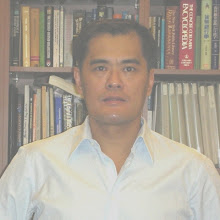★★ Detailed Solution to Examination 1 (Int'l Business, WUCL) ★★
Summer 2009 Instructor: 衛忠欣 (Jong-Shin Wei)
總體經濟學原理 (Principles of Macroeconomics) (07)342-6031 ext.6222
93001@mail.wtuc.edu.tw jsw12011958@gmail.com
2:50 pm ~ 4:00 pm, July 3, 2009
Open books/notes exam. 100 points in 70 minutes; absolutely no talking nor borrowing items during exams. 可使用自己的資料、字典或翻譯機。行動電話若響起,該生扣十分、以強調基本禮貌。務必工整依序作答。
Part One: 10 Multiple choice questions. [By multiple choice in an English-speaking academic environment, we mean that you must choose the most appropriate one from 4 alternatives. 依慣例,答錯不倒扣!] 50 points
1. Before taking externality into consideration, we know that demand for aluminum is P + Q = 10; supply of aluminum is 3P - 2Q = 0. At equilibrium, P* =
(A) 4;
(B) 6;
(C) 5;
(D) None of the above is correct.
Ans: A. [By quantity demanded equals quantity supplied, we have Q* = 6 and P* = 4.]
2. [continued from question 1] Q* =
(A) 4;
(B) 5;
(C) 6;
(D) None of the above is correct.
Ans: C.
3. [continued from question 1] The market allocates resources in a way that it maximizes the total value to the consumers who buy and use aluminum minus the total costs to the producers who make and sell aluminum. Here, the maximized value is
(A) 12 (dollars);
(B) 20;
(C) 30;
(D) 25.
Ans: C. [Recall that CS + PS is the area of the triangle with vertex points (0, 10), (0, 0), and (6, 4), which is 30.]
4. [continued from question 3] Here, the insight is:
(A) Markets are usually a good way to organize economic activity;
(B) Governments can sometimes improve market outcomes;
(C) Sometimes we have government failure;
(D) There is no such thing as a free lunch.
Ans: A. [See p.203, text]
5. [continued from question 1] We now take negative externality into consideration. Suppose that the new supply (curve) of aluminum becomes 3P - 2Q = 3 while the demand for aluminum remains the same. This suggests that producing each unit of aluminum adds external cost to the society in the amount of
(A) 4 (dollars);
(B) 3;
(C) 2;
(D) 1.
Ans: D. [From P = (2/3)Q to P = (2/3)Q + 1]
6. [continued from question 5] The new equilibrium price is
(A) 23/3;
(B) 20/3;
(C) 23/5;
(D) 4.
Ans: C. [From P + Q = 10 and 3P - 2Q = 3 we obtain Q** = 27/5 and P** = 23/5.]
7. The best way to measure the annual economic performance of a country is to find her
(A) income;
(B) population;
(C) stock index;
(D) education.
Ans: A. [Recall lecture]
8. “How can you put a price on clean air and clean water?!” is a strong statement often made by
(A) environmentalists;
(B) politicians;
(C) soldiers;
(D) economists.
Ans: A. [See p.219, text]
9. If Highway 88 (mentioned in class) becomes highly congested, the first reaction that the government might have is to
(A) build another highway;
(B) widen it;
(C) shut it down twice a day;
(D) charge drivers a toll.
Ans: D. [See p.233, text]
10. Which of the following can best reduce the level of pollution?
(A) issuing more pollution permits;
(B) raising the corrective tax;
(C) lowering the corrective tax;
(D) allowing firms to trade pollution permits.
Ans: B. [p.217, text]
Part Two: Analytical questions. [注意字體工整、邏輯順暢與不要出現錯別字或注音(與火星文)!如果字跡難以辨認,視同未答。畫蛇添足、答非所問、不知所云、自曝其短,將不利得分。教師也有權公告具有特色之作答。] 50 points
11. Initial pollution levels of three firms are: 70, 80, and 50 units for factories A, B, and C respectively. The cost of reducing pollution by one unit is $20, $25, and $10
respectively. [Assume that the cost structure is linear.] The government wants to reduce the total pollution to 120 units and gives each 40 (units of) tradable pollution permits. What happens if each firm gets 40 pollution permits which are not tradable?
Ans: Firm A must reduce pollution by 30 units, causing her $600. Firm B must reduce pollution by 40 units, causing her $1,000. Firm C must reduce pollution by 10 units, causing her $100.
12. [continued from question 11] Will the price for tradable pollution permits be 20 or 15? How about 25? Justify your answer.
Ans: Firm C sells 40 permits to B at price 20, causing B $800. Note that -800 > -1000. Such a transaction makes C earn 800 - (50)(10) = 300, which is better than -100. We see that the aforementioned trade benefits both B and C (while having no effect on A).
13. 如果國家公園 (e.g., Grand Canyon) 一方面大幅提高門票價格,也同時提供當地居民優惠入場。理由為何?
Ans: skipped. [See text]
14. Make your own example of illustrating how Coase theorem can be used to resolve the problem with externalities, similar to pp.210-211, text.
Ans: skipped.
15. Write down five most important things for you to do if you are a teacher assigned to teach a course that you are not familiar with.
Ans: For instance,
(i) 將學生分組,輪流上台報告
(ii) 以報告代替考試
(iii) 要求書商提供全套 PPT 與題庫光碟
(iv) 大量請求業界人士來進行協同教學
(v) 常常呼應同學之要求,於課堂播放電影
(vi) 試題回收、嚴禁外洩。不提供解答 (即使提供解答,也只限於板書模式)
(撰寫試題無著作權;歡迎全貌下載流傳。)
skip to main |
skip to sidebar

appreciate good economics and writing at the following sites
About Me

- jsw12011958
- Busy as I am, little accomplished as I was told, I am walking down this long and winding road for decades. I wish to spend time on building a small corner for recording my simple and sometimes naive ideas in economics, which has attracted me since the early 1980s. I admit, with regret, that my posting will be in English as well as Chinese.